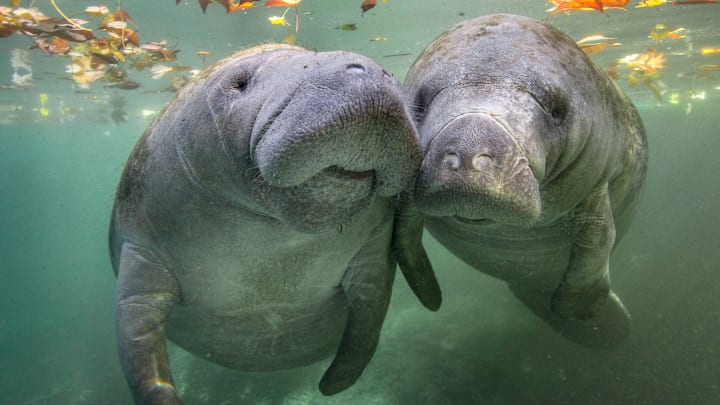In 1493, Christopher Columbus mistook three manatees for mermaids. They’re “not half as beautiful as they are painted,” he noted. The manatees vs. mermaids debate is really a matter of opinion, but here are some things you might not know—or appreciate—about these rotund aquatic mammals.
- Manatee comes from a Carib word.
- Manatees are the ocean’s largest herbivores.
- Manatees can swim up to 20 mph.
- There are three species of manatee.
- Sailors mistook manatees for mermaids.
- Manatees can hold their breath underwater for 15 to 20 minutes.
- You’ll be arrested for harassing a manatee.
- Manatees are closely related to elephants.
- Boats are one of the Florida manatee’s biggest threats.
- Manatees have sensitive whiskers called vibrissae.
- Manatees have the smallest brain of all mammals in relation to body mass.
- Manatees are nearsighted.
- Read More About Animals:
Manatee comes from a Carib word.

The manatee’s name is derived from manati, a Carib term meaning “breast” or “udder.” These docile creatures are also called sea cows.
Manatees are the ocean’s largest herbivores.

Manatees live in coastal waters and rivers in the Caribbean, Amazon, and western Africa. An adult can grow up to 13 feet long and weigh as much as 1300 pounds—and can consume 10 to 15 percent of its body weight in vegetation each day.
Manatees can swim up to 20 mph.
Using their powerful, paddle-shaped tails, manatees can swim for short bursts at up to 20 mph. But the placid animals are usually content to cruise along at 5 mph.
There are three species of manatee.
Common Name | Scientific Name | Location |
|---|---|---|
West Indian manatee | Trichechus manatus | Coastal waters of the Caribbean Sea |
West African manatee | Trichechus senegalensis | Coastal waters along Western Africa |
Amazonian manatee | Trichechus inunguis | The Amazon Basin |
It’s easy to tell where each species lives—it’s right there in their common names. The West Indian manatee (Trichechus manatus) inhabits the coastal waters of the Caribbean Sea. Its two subspecies, the Florida manatee (T. manatus latirostris) and the Antillean manatee (T. manatus manatus) are both listed as “threatened” by the U.S. Fish and Wildlife Service and are protected by law. Along with the West Indian manatee, the West African manatee (Trichechus senegalensis), and the Amazonian manatee (Trichechus inunguis) belong to the order Sirenia, which also includes the dugong (Dugong dugon) and the extinct Steller’s sea cow (Hydrodamalis gigas).
Sailors mistook manatees for mermaids.

According to a ship log dated January 9, 1493, Christopher Columbus said that on the previous day he “distinctly saw three mermaids, which rose well out of the sea; but they are not so beautiful as they are said to be, for their faces had some masculine traits.” Columbus wasn’t the only sailor to spot mermaids in the water. The reason they weren’t as beautiful as he might have imagined is because they were actually manatees.
Manatees can hold their breath underwater for 15 to 20 minutes.

Manatees usually surface every three to five minutes to breathe. With a single breath, manatees can replace 90 percent of the air in their lungs; humans, by comparison, replace just 10 percent.
You’ll be arrested for harassing a manatee.
Back in 2012, a woman was arrested in Florida for riding a manatee. Why the drastic measure? Because West Indian manatees are protected by the federal Marine Mammal Protection Act and Florida’s Manatee Sanctuary Act, which states that it’s against the law for “any person at any time, by any means, or in any manner intentionally or negligently to annoy, molest, harass, or disturb or attempt to molest, harass, or disturb” the endangered animals. Yes, that includes riding one.
Manatees are closely related to elephants.

The manatee’s land-based cousins, the elephant and the hyrax, share a heart shape that is rounded on the bottom. Most animals have hearts that come to a point on the bottom.
Boats are one of the Florida manatee’s biggest threats.

Manatees are threatened by a number of things, including toxic algae (a.k.a. red tide) and run-ins with watercraft. Collisions with boats are the leading cause of death for the gentle giants in Florida. A 2004 study also found that 97 percent of manatees in Florida bore scars from boat collisions.
Manatees have sensitive whiskers called vibrissae.

Adult manatees have about 2000 of the thick hairs on their faces, and 3000 on their bodies. These innervated follicles help the manatee sense and explore the world around it.
Manatees have the smallest brain of all mammals in relation to body mass.

But don’t call them stupid. According to a 2006 article in The New York Times on the work of Roger L. Reep, a neuroscientist at the University of Florida at Gainesville, manatees are “as adept at experimental tasks as dolphins, though they are slower-moving and, having no taste for fish, more difficult to motivate.”
Manatees are nearsighted.

The animals can see color in the blue, green, and gray spectrum, but not in red or blue-green combinations.
This story originally ran in 2015; it has been updated for 2024.
